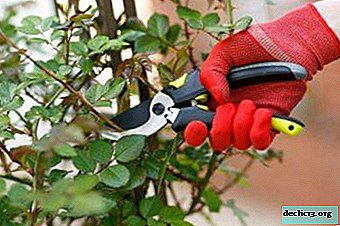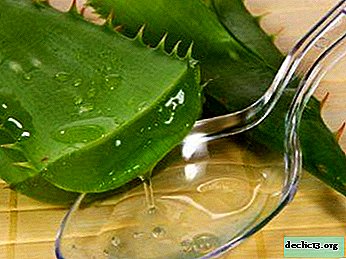A practical guide for grafting roses in the fall at home

Rose is the real queen of the garden, which, in addition to its decorative appearance, attracts with its rich aroma.
You need to take care of the rose all year round, then it will bloom profusely. To propagate a home rose, flower growers use cuttings, as it is simple, quick and effective.
We’ll tell you how you can grow a beautiful flower from a stalk at home and what kind of care he subsequently needs. In addition, we will talk about possible problems during the rooting of a plant.
Cuttings as a way of propagation
A shank is a separate part of a plant (shoot), and cuttings are vegetative propagation with its use. Plants can reproduce both sexually and asexually, which is called the vegetative. It is for him that cuttings are used.
Using the cuttings of roses at home, you can quickly and inexpensively get a home collection of flowers.When can it be produced?
You can carry out home cuttings of roses in autumn or spring. The effectiveness of the breeding procedure is directly related to the varietal characteristics of the plant and its affiliation group.
Features of the procedure in the autumn
 Autumn cuttings of roses has the following features:
Autumn cuttings of roses has the following features:
- shoots taken from a plant take root better and are less likely to get sick;
- if you root dozens of cuttings, you can get a mini-rose garden at home without any special material costs;
- the plant is prepared for winter peace and maximum accumulation of nutrients;
- when pruning in the fall and preparing a decorative culture for wintering, it is possible to choose the most suitable and high-quality planting material.
How to propagate a flower at home?
Inventory and materials
For the preparation of cuttings, it is necessary to prepare a sharp knife or scalpel. Otherwise, the shoot tissue will be bent, and this is fraught with the process of decay. All instruments must be disinfected with alcohol. It is also necessary to prepare Kornevin, which will be used to dust the place of cut.
Preparation of soil and pots
To cut the domestic rose, you need to prepare a spacious and deep container. A plastic bucket is best suited, as it does not freeze, unlike a metal one. A drainage layer (5 cm thick) is laid at the bottom of the container. Suitable river pebbles or expanded clay of the middle fraction.Soil composition is important for rose cuttings. The plant will grow and develop in loose, rich in organic matter and fertile soil. To prepare it, you must mix the following components:
- turf land - 2 parts;
- sheet earth - 1 part;
- sand - 1 part.
After mixing all the components, the resulting mixture must be calcined in an oven at a temperature of 180 degrees for 20 minutes.
Some gardeners prefer to grow a rose from cuttings in potatoes. Read about how to do this at home.
Shoots
 The process of cutting planting material is as follows:
The process of cutting planting material is as follows:
- Choose healthy ripened shoots, the thickness of which is 4-5 mm.
- Cut them into small pieces. Each shoot should have 3-5 developed buds.
- At the top, the slices should be straight, and at the bottom, along the oblique. This is necessary in order not to get confused which part to plant the stalk.
- The upper section is made 2-3 cm above the upper kidney, and the lower one is under the lower kidney.
- If the rooting of the rose cuttings will occur immediately, then it is not necessary to pick off all the leaves, you need to leave 2-3. Bottom should be completely removed.
Treatment
After cutting the cuttings, it must be immersed in water for 2-3 minutesand then treat the places of cuts with Kornevin powder, which is a stimulator of root system growth.
Landing
Autumn pruning ends with the planting of cuttings in a permanent place, then the plant is subjected to minimal stress and better survives in a new place.How to plant:
- Pour the prepared substrate onto the drainage laid in a plastic bucket. Dig a hole 30 cm deep.
- Run off shoots at a slope of 45 degrees. 1/3 of the cuttings or 1-2 buds should remain above the ground.
- Water the planted plants abundantly.
Rooting
 Now we’ll show you how to root your escape. After planting rose cuttings, sprinkle them with water and cover with polyethylene to maintain a constant temperature regime.
Now we’ll show you how to root your escape. After planting rose cuttings, sprinkle them with water and cover with polyethylene to maintain a constant temperature regime.
Set the container with landed cuttings in a warm place where the air temperature is 22-25 degrees. Choose a place protected from direct sunlight. To maintain high humidity, sprouts have to be sprayed from time to time.
As soon as small sprouts are found in the axils of the leaves, this is a signal that the rooting has occurred. From this time, you can harden the plant by removing the polyethylene for 2 hours and controlling the soil moisture.
Further care in the apartment
Air humidity
When growing such a rose in a room the plant negatively reacts to extreme cold and excessive heat. For this reason, in winter, keep the plant away from heating appliances or batteries. In summer, it is better to transfer the rose to a place where there will be relative coolness, for example, a balcony. All types of roses respond positively to high humidity, so you need to carry out regular moisturizing from the spray gun.
Lighting
Rose negatively reacts to the influence of direct sunlight, which injure the foliage, leaving burns on it. It is better to arrange the plant in a dark place or to take it from direct rays. But poor lighting will adversely affect the flower, which will stop the development and lose its decorative appearance.
Watering
Immediately after the stalk gives roots, it must be accustomed to fresh air. Only do it gradually - 2-3 hours a day. On the first day, watering is important for the plant. After wetting, the soil should not be wet, otherwise it is fraught with the development of rot and death of the flower.Care must be taken to keep the soil slightly moist.. It is better to water the rose often, but use a small amount of water.
Top dressing
A rose needs to be systematically fed. For these purposes, mineral and organic compounds are used.
Problems and solutions
 When cutting roses in autumn, gardeners have the following difficulties:
When cutting roses in autumn, gardeners have the following difficulties:
- Irregular Watering. Rosa prefers systematic watering during the growing season. The maximum amount of moisture is necessary during a period of intensive growth and budding.
- Plant density. Because of this, plants do not receive enough air, as a result of which they are affected by pests and diseases.
- Lack of lighting. Often, flower growers install a container with cuttings in the corner of the room, where the plant does not have enough light. Because of this, it may not give roots or bloom.
Cuttings of home roses are most often carried out precisely in the fall. At this time, the cuttings take root better and adapt to winter. If all the events were carried out correctly, then in the spring the rose will bloom and will delight with its magical aroma.
Interesting video
We offer you to watch a video about the cuttings of roses:

















